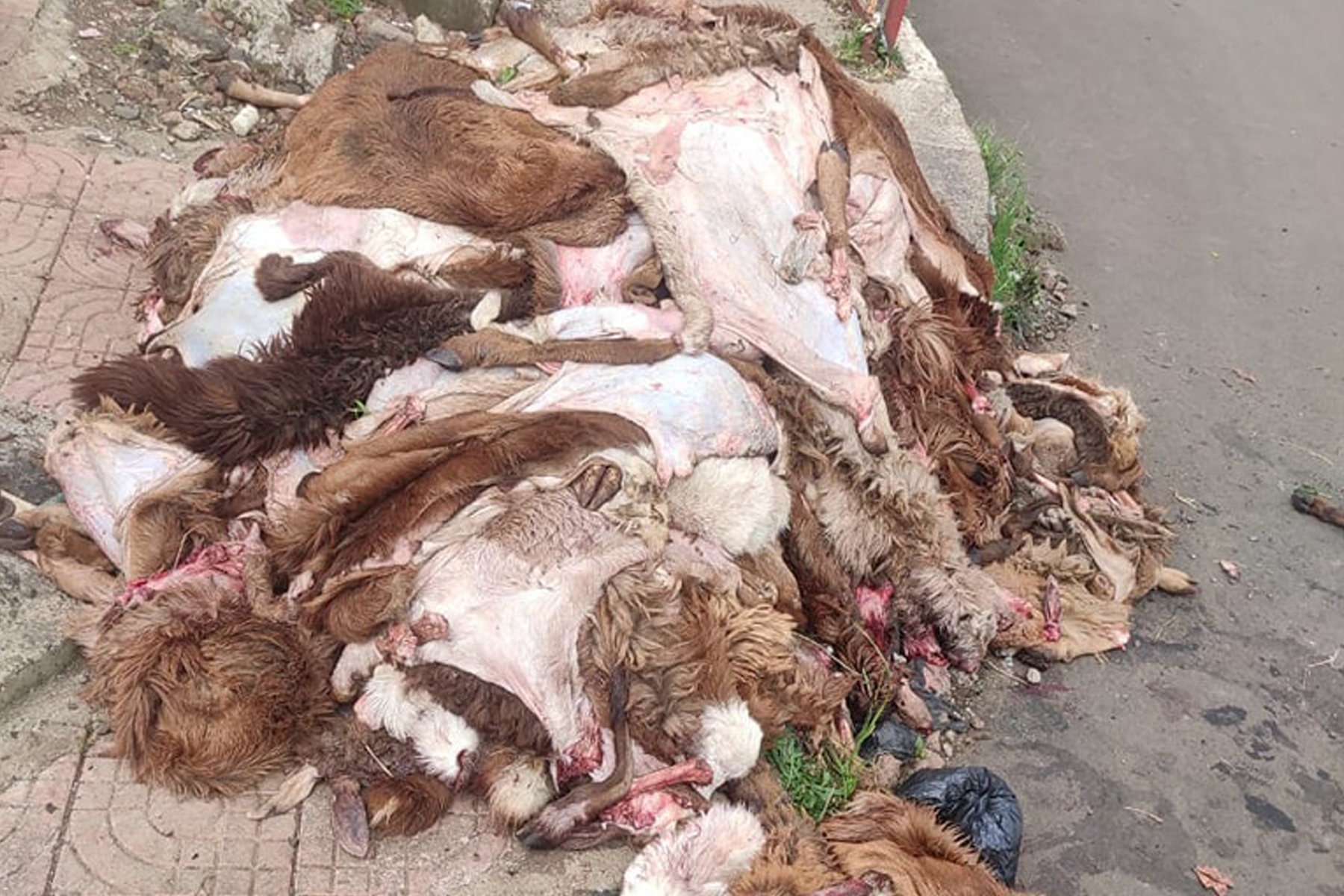
Horticultural spaces unfold a few kilometres away from the capital into eastern Shoa, Oromia Regional State. Agroecology, with its long sunny days, plays a pivotal role in the flower industry, providing an ideal growth opportunity for 120 export companies in the country. Approximately 96Km away lies Koka town, nestled between the Mojo-Awassa highway and the Awash River. Its location and humid climate have made it a haven for floral growers.
The Dutch-ventured Red Fox Flower Farms enjoyed 13 years of blooming success, exporting stems and cuttings to international markets. On a 40hct flower farm along the river, cut flowers thrive in 14 shaded greenhouses. The cutting process goes through four stages: breeding (which can take up to five years), plant propagation, production, preparation, and export.
Red Fox has a total of 1,300 permanent staff, with 75pc of the workforce being women. Inside one of the sheds, rows of Poinsettias are carefully tended by gloved and focused young women who meticulously inspect for pests. According to Yordanos Jemal, the farm manager, new projects are designed to align with evolving market demands.
"We're adapting to changes," she said.
Ethiopia has seen major success in flower exports since the mid-2000s, generating 225 million dollars in 2015 and over half a billion dollars last year. However, FDI rates have declined, dropping by 16.4pc to 3.3 billion dollars the same year. Despite a 100 million dollar drop in flower export earnings last year, the country remains one of the top six exporters. Incentives include easy access to rural and urban agricultural land at nominal lease rates, income tax exemptions for up to five years, and duty-free importation of equipment, vehicles, building materials, and irrigation systems.
The flower industry primarily sources its blooms from commercial farms in clusters such as Holleta, Bishoftu (Debrezeit), Sebeta, Ejersa, Welisso, Wolkite, Sendafa, and Bahir Dar. Oromia Regional State, home to nearly 70pc of Ethiopia's flower exporters, recently introduced a new land lease directive for flower farm investors. The directive categorises towns based on proximity to urban centres, encompassing a total of 143 towns. Sheger City falls under the Metropolis category, while Regiopolis includes Bishoftu, Shashemene, and Adama. Prime cities include Maya, Robe, Nekemt, and Jimma, with Batu and Holeta among the Higher cities. Lease rates vary depending on the category, ranging from 1.84 Br to 4.04 Br per square meter. They are set for a 15-year term with a 10pc down payment upfront, followed by payments spread over seven years.
At its peak, Red Fox shipped 120 million stems, garnering over 10 million euros. However, with a dwindling market share and a shortage of crucial inputs, the company, along with other flower farms, faces challenges.
Europe plays a pivotal role in Ethiopia's flower exports, accounting for nearly a third of demand. The recent decision by the United Kingdom to suspend tariffs on fresh-cut flower imports has breathed new life into the industry, igniting optimism and aspirations for the sector. The Netherlands, in particular, accounts for a major portion of the exports, making it a crucial distribution point for the country's supply.
According to Mekonnen Solomon, horticulture coordinator at the Ministry of Agriculture, maritime access to flower exports has shown promising results from previous trials. He said the recent inaugural shipments by sea to European markets are a step towards managing logistics costs and improving overall export performance.
However, challenges persist. Apart from the Red Sea crisis, Mekonnen notes that the absence of raw materials has increased market demand.
Exporters are finding the domestic market more lucrative. Tewodros Zewde, of the Ethiopian Horticulture Processors and Exporters Association, lauds the growth of the flower industry over the past two decades. He recommends adapting to the domestic market as international demand dwindles.
With declining international demand, some farms are shifting focus to the domestic market and new products like herbs. Joytech Plc, a sprawling 100hct expanse in Bishoftu (Debrezeit), have introduced technological advances, including cell multiplication. The company began producing bananas by extending the tissue of the parent plant from the roots and multiplying it. With 1,400 employees, Joytech has gradually phased out its flower plantations in favour of herbs and vegetables.
Herbs usually take 20 days to become market-ready, stored in rooms at up to 14 degrees Celsius. Tesfaye Tizazu, herb manager, said they thrive on exporting one million kilograms of herbs annually.
"Herbs require more work but are rewarding," he said.
The company generates up to 12 million dollars during its peak. According to Bisrat Hailselassie, the farm manager, the shift to herbs amid dwindling flower demand from the international market has been advantageous. Joytech exports over 90pc of its products to Europe, where delays in raw material imports have posed difficulties.
As flowers are a luxury item, demand is bound to fluctuate, making Ethiopia's reliance on Europe's market precarious. Experts suggest exploring other markets as an antidote to the expected crisis in the flower industry.
Shimeles Araya, an agricultural economist, notes that the international market has shown a downturn due to geopolitical tensions and inflation in Europe. He recommends adapting to changing markets and diversifying the export base to other countries to reduce exposure to price volatility.
The floriculture industry also plays a part in the employment arena. The farm workers' salary hovers around 3,000 Br, not keeping pace with the inflation rate. Workers such as Desta Fisseha and Shitu Gudeta appreciate the job opportunities and the chance to master their skills. However, with the stagnant wage and demanding work, they say keeping up with the price of goods has become difficult.
The flower industry blooms with potential, but passing through a changing global market requires agility. While its economic contributions remain undeniable, challenges like fluctuating market demands and global uncertainties threaten its future. By embracing new technologies, diversifying exports, and exploring domestic opportunities, the flower farms can weather difficult days and blossom anew.
PUBLISHED ON
Jun 22,2024 [ VOL
25 , NO
1260]

Fortune News | Sep 09,2023

Fortune News | Aug 14,2021

Editorial | Mar 27,2021

Fortune News | Aug 08,2020

Radar | Jun 01,2024

Obituary | Nov 16,2019

Radar | Dec 15,2024

Editorial | Oct 21,2023

Fortune News | Apr 06,2024

Featured | Jan 05,2020

Dec 22 , 2024 . By TIZITA SHEWAFERAW
Charged with transforming colossal state-owned enterprises into modern and competitiv...

Aug 18 , 2024 . By AKSAH ITALO
Although predictable Yonas Zerihun's job in the ride-hailing service is not immune to...

Jul 28 , 2024 . By TIZITA SHEWAFERAW
Unhabitual, perhaps too many, Samuel Gebreyohannes, 38, used to occasionally enjoy a couple of beers at breakfast. However, he recently swit...

Jul 13 , 2024 . By AKSAH ITALO
Investors who rely on tractors, trucks, and field vehicles for commuting, transporting commodities, and f...

Oct 11 , 2025
Ladislas Farago, a roving Associated Press (AP) correspondent, arrived in Ethiopia in...

Oct 4 , 2025
Eyob Tekalegn (PhD) had been in the Governor's chair for only weeks when, on Septembe...

Sep 27 , 2025
Four years into an experiment with “shock therapy” in education, the national moo...

Sep 20 , 2025
Getachew Reda's return to the national stage was always going to stir attention. Once...